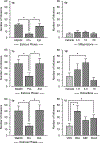Modulation of heroin intake by ovarian hormones in gonadectomized and intact female rats
- PMID: 33404736
- PMCID: PMC8218341
- DOI: 10.1007/s00213-020-05743-1
Modulation of heroin intake by ovarian hormones in gonadectomized and intact female rats
Abstract
Rationale: Heroin intake decreases during the proestrus phase of the estrous cycle in female rats. Circulating concentrations of both estradiol and progesterone peak during proestrus, and it is not known which of these hormones, or their combination, are responsible for these effects.
Objectives: The purpose of this study was to determine the effects of estradiol, progesterone, and their combination on heroin self-administration in female rats.
Methods: In Experiment 1, the estrous cycle of intact female rats was tracked daily. If a rat was in proestrus, either the estrogen receptor antagonist, raloxifene, the progesterone receptor antagonist, mifepristone, or their combination was administered 30 min prior to a heroin self-administration session. In Experiment 2, separate groups of ovariectomized female rats were treated chronically with exogenous estradiol, progesterone, estradiol + progesterone, or vehicle, and heroin intake was examined over a 100-fold dose range.
Results: In Experiment 1, raloxifene, but not mifepristone, significantly blocked proestrus-associated decreases in heroin intake. In Experiment 2, estrogentreated rats self-administered less heroin than any other group and significantly less heroin than rats treated with progesterone.
Conclusions: These data suggest that (1) estradiol but not progesterone is responsible for proestrus-associated decreases in heroin intake and (2) estradiol decreases heroin intake relative to progesterone. These data differ from those reported previously with stimulants and suggest that estrogen-based pharmacotherapies may be of value to women with opioid use disorder.
Keywords: Addiction; Estradiol; Opioid; Progesterone; Self-administration.
Conflict of interest statement
Figures



Similar articles
-
The effects of artificially induced proestrus on heroin intake: A critical role for estradiol.Exp Clin Psychopharmacol. 2022 Apr;30(2):127-131. doi: 10.1037/pha0000428. Epub 2020 Oct 1. Exp Clin Psychopharmacol. 2022. PMID: 33001695 Free PMC article.
-
The effects of chronic estradiol treatment on opioid self-administration in intact female rats.Drug Alcohol Depend. 2021 Aug 1;225:108816. doi: 10.1016/j.drugalcdep.2021.108816. Epub 2021 Jun 18. Drug Alcohol Depend. 2021. PMID: 34171824 Free PMC article.
-
Estrogen-induced calbindin-D 9k gene expression in the rat uterus during the estrous cycle: late antagonistic effect of progesterone.Endocrinology. 1993 Feb;132(2):489-95. doi: 10.1210/endo.132.2.8425470. Endocrinology. 1993. PMID: 8425470
-
The effects of gonadal hormones on heroin Self-Administration in male gonadectomized rats.Psychopharmacology (Berl). 2024 Jan;241(1):171-179. doi: 10.1007/s00213-023-06471-y. Epub 2023 Oct 13. Psychopharmacology (Berl). 2024. PMID: 37833541 Free PMC article.
-
Roles of estradiol and progesterone in regulation of hippocampal dendritic spine density during the estrous cycle in the rat.J Comp Neurol. 1993 Oct 8;336(2):293-306. doi: 10.1002/cne.903360210. J Comp Neurol. 1993. PMID: 8245220
Cited by
-
Effects of fentanyl on acute locomotor activity, behavioral sensitization, and contextual reward in female and male rats.Drug Alcohol Depend. 2021 Dec 1;229(Pt A):109101. doi: 10.1016/j.drugalcdep.2021.109101. Epub 2021 Sep 24. Drug Alcohol Depend. 2021. PMID: 34628096 Free PMC article.
-
Sex/Gender Differences in the Time-Course for the Development of Substance Use Disorder: A Focus on the Telescoping Effect.Pharmacol Rev. 2023 Mar;75(2):217-249. doi: 10.1124/pharmrev.121.000361. Epub 2022 Dec 12. Pharmacol Rev. 2023. PMID: 36781217 Free PMC article. Review.
-
The importance of translationally evaluating steroid hormone contributions to substance use.Front Neuroendocrinol. 2023 Apr;69:101059. doi: 10.1016/j.yfrne.2023.101059. Epub 2023 Feb 7. Front Neuroendocrinol. 2023. PMID: 36758769 Free PMC article. Review.
-
Chronic inflammatory pain promotes place preference for fentanyl in male rats but does not change fentanyl self-administration in male and female rats.Neuropharmacology. 2023 Jun 15;231:109512. doi: 10.1016/j.neuropharm.2023.109512. Epub 2023 Mar 21. Neuropharmacology. 2023. PMID: 36948356 Free PMC article.
-
Effects of the glucocorticoid receptor antagonist PT150 on stress-induced fentanyl seeking in male and female rats.Psychopharmacology (Berl). 2021 Sep;238(9):2439-2447. doi: 10.1007/s00213-021-05865-0. Epub 2021 May 18. Psychopharmacology (Berl). 2021. PMID: 34008048 Free PMC article.
References
MeSH terms
Substances
Grants and funding
LinkOut - more resources
Full Text Sources
Other Literature Sources
Research Materials

